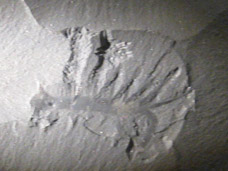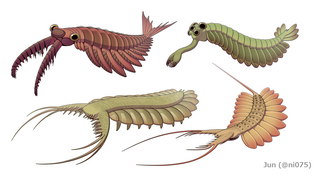
The lobopodians, members of the informal group Lobopodia, or the formally erected phylum Lobopoda Cavalier-Smith (1998), are panarthropods with stubby legs called lobopods, a term which may also be used as a common name of this group as well. While the definition of lobopodians may differ between literatures, it usually refers to a group of soft-bodied, worm-like fossil panarthropods such as Aysheaia and Hallucigenia.

Onychophora, commonly known as velvet worms or more ambiguously as peripatus, is a phylum of elongate, soft-bodied, many-legged panarthropods. In appearance they have variously been compared to worms with legs, caterpillars, and slugs. They prey upon smaller animals such as insects, which they catch by squirting an adhesive slime.

The integumentary system is the set of organs forming the outermost layer of an animal's body. It comprises the skin and its appendages, acting as a physical barrier between the external environment and the internal environment that it serves to protect and maintain.

Hallucigenia is a genus of Cambrian animal known from articulated fossils in Burgess Shale-type deposits in Canada and China, and from isolated spines around the world. The generic name reflects the type species' unusual appearance and eccentric history of study; when it was erected as a genus, H. sparsa was reconstructed as an enigmatic animal upside down and back to front. Hallucigenia is later recognized as part of lobopodians, a grade of paleozoic panarthropods where the velvet worms, water bears and arthropods arose.

Opabinia regalis is an extinct, stem group arthropod found in the Middle Cambrian Burgess Shale Lagerstätte of British Columbia. Opabinia was a soft-bodied animal, measuring up to 7 cm in body length, and its segmented trunk had flaps along the sides and a fan-shaped tail. The head shows unusual features: five eyes, a mouth under the head and facing backwards, and a clawed proboscis that probably passed food to the mouth. Opabinia probably lived on the seafloor, using the proboscis to seek out small, soft food. Fewer than twenty good specimens have been described; 3 specimens of Opabinia are known from the Greater Phyllopod bed, where they constitute less than 0.1% of the community.

Dinocaridida is a proposed fossil taxon of basal arthropods flourished in the Cambrian period with occasional Ordovician and Devonian records. Characterized by a pair of frontal appendages and series of body flaps, the name of Dinocaridids comes from Greek, "deinos" and "caris", referring to the suggested role of some of these members as the largest marine predators of their time. Dinocaridids are occasionally referred to as the 'AOPK group' by some literatures, as the group compose of Radiodonta, Opabinia, Pambdelurion and Kerygmachela. It is most likely paraphyletic, with Kerygmachela and Pambdelurion more basal than the clade compose of Opabinia, Radiodonta and other arthropods.

The Emu Bay Shale is a geological formation in Emu Bay, South Australia, containing a major Konservat-Lagerstätte. It is one of two in the world containing Redlichiidan trilobites. The Emu Bay Shale is dated as Cambrian Series 2, Stage 4, correlated with the upper Botomian Stage of the Lower Cambrian.

Scipionyx is a genus of theropod dinosaur from the Early Cretaceous of Italy, around 113 million years ago.

The Orsten fauna are fossilized organisms preserved in the Orsten lagerstätten of Late Series 3, Stage 4 to Furongian rocks, notably at Kinnekulle and on the island of Öland, all in Sweden.

Kerygmachela kierkegaardi is a gilled lobopodian from the Buen Formation of the Sirius Passet Lagerstätte, in northern Greenland. Its anatomy strongly suggests that it, along with its relative Pambdelurion whittingtoni, was a close relative of radiodont (anomalocaridids) and euarthropods. The generic name "Kerygmachela" derives from the Greek words Kerygma (proclamation) and Chela (claw), in reference to the flamboyant frontal appendages. The specific name, "kierkegaardi" honors Danish philosopher Søren Kierkegaard.
The Chancelloriids are an extinct family of animal common in sediments from the Early Cambrian to the early Late Cambrian. Many of these fossils consists only of spines and other fragments, and it is not certain that they belong to the same type of organism. Other specimens appear to be more complete and to represent sessile, bag-like organisms with a soft skin armored with star-shaped calcareous sclerites from which radiate sharp spines.

Class Xenusia, the Xenusiids, represents the subset of lobopodian worms that fall in the stem-lineage of Onychophora. Their type genus is Xenusion. They have relatively large, annulated, cylindrical bodies. Their lobopod legs have tubercles at their bases. Some have large frontal appendages, although these may represent taphonomic artefacts. Their mouth is terminal or subterminal, and they are marine. They probably represent a grade rather than a clade.

Radiodonta is an extinct order of stem-group arthropods that was successful worldwide during the Cambrian period. They may be referred to as radiodonts, radiodontans, radiodontids, anomalocarids, or anomalocaridids, although the latter originally refer to the family Anomalocarididae, which previously included all species of this order but is now restricted to only a few species. Radiodonts are distinguished by their distinctive frontal appendages, which are morphologically diverse and used for a variety of functions. Radiodonts included the earliest large predators known, but they also included sediment sifters and filter feeders. Some of the most famous species of radiodonts are the Cambrian taxa Anomalocaris canadensis, Hurdia victoria, Peytoia nathorsti, and Amplectobelua symbrachiata, the Ordovician Aegirocassis benmoulai and the Devonian Schinderhannes bartelsi.
Mobergella is a millimetric Lower Cambrian shelly fossil of unknown affinity, usually preserved in phosphate and particularly well known from Swedish strata, where it is diagnostic of lowermost Cambrian rocks. Originally interpreted as a monoplacophoran, the circular, cap-shaped shell resembles a hyolith operculum, with concentric rings on its upper surface, and seven pairs of internal muscle scars. It is never found in association with a conch, and its affinity therefore remains undetermined. Nevertheless, its heavy musculature does seem to indicate that it functioned as an operculum.
Mongolitubulus is a form genus encapsulating a range of ornamented conical small shelly fossils of the Cambrian period. It is potentially synonymous with Rushtonites, Tubuterium and certain species of Rhombocorniculum, and owing to the similarity of the genera, they are all dealt with herein. Organisms that bore Mongolitubulus-like projections include trilobites, bradoriid arthropods and hallucigeniid lobopodians.

Diania is an extinct genus of lobopodian animal found in the Lower Cambrian Maotianshan shale of China, represented by a single species D. cactiformis. Known during its investigation by the nickname "walking cactus", this organism belongs to a group known as the armoured lobopodians and has a simple worm-like body with robust, spiny legs. Initially, the legs were thought to have jointed exoskeleton and Diania was suggested to be close to the origins of arthropods, but many later studies have denied this interpretation.

Ovatiovermis is a genus of filter-feeding lobopodian known from the Burgess Shale. Like many lobopodians, it had nine pairs of lobopods (legs). It was well adapted to filter-feeding and probably did so from the nearest high vantage point.

Megadictyon is a genus of cambrian lobopodian with similarities to Jianshanopodia and Siberion. Occasionally mis-spelt Magadictyon.

Onychodictyon is a genus of extinct lobopodian known from the Lower Cambrian Chengjiang Maotianshan Shales in the Yunnan Province in China. It was characterized by a stout body covered by fleshy papillae and pairs of sclerotized plates with spines, representing part of the diverse "armoured lobopodians" alongside similar forms such as Microdictyon and Hallucigenia.

Muensterelloidea is a superfamily of stem-octopod cephalopods from the Early Jurassic to Late Cretaceous. Two families are currently identified, Muensterellidae, and Patelloctopodidae. The clade is the ancestral group from which modern octopus arose.















